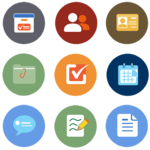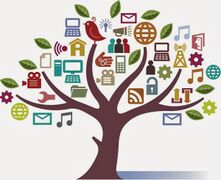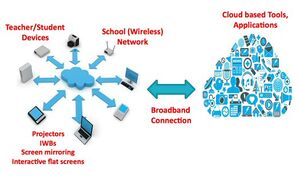Différences entre versions de « ICT and ineractive learning »
| (7 versions intermédiaires par 2 utilisateurs non affichées) | |||
| Ligne 12 : | Ligne 12 : | ||
<!-- ****************** Commercez les modifications ************************--> | <!-- ****************** Commercez les modifications ************************--> | ||
| − | [[ | + | [[TIC et apprentissage interactif]] (Français) |
/ [[ICTs and interactive learning]] (Anglais) | / [[ICTs and interactive learning]] (Anglais) | ||
/ [[تكنولوجيا المعلومات و التعلم التفاعلي]] (Arabe) | / [[تكنولوجيا المعلومات و التعلم التفاعلي]] (Arabe) | ||
| Ligne 18 : | Ligne 18 : | ||
}}<!-- ************** Fin Fiche Didactique Traduction ********************* --> | }}<!-- ************** Fin Fiche Didactique Traduction ********************* --> | ||
| − | + | = {{Widget:Definition-Fiche}} = | |
| − | |||
| Ligne 105 : | Ligne 104 : | ||
{{Gg}} [https://www.google.com/search?q={{PAGENAME}} {{PAGENAME}}] | {{Gg}} [https://www.google.com/search?q={{PAGENAME}} {{PAGENAME}}] | ||
{{Commons}} [https://commons.wikimedia.org/w/index.php?search={{PAGENAME}} {{PAGENAME}}] | {{Commons}} [https://commons.wikimedia.org/w/index.php?search={{PAGENAME}} {{PAGENAME}}] | ||
| − | {{cc}} Représentation graphique spatiale [https:// | + | {{cc}} Représentation graphique spatiale [https://cmapscloud.ihmc.us/viewer/cmap/1ZT4B6Y7H-12TCZC5-WBNFZ2 ICT and Interactive Learning]''' |
}}<!-- ************************* Fin modifications pour les Médias *******************************************************--> | }}<!-- ************************* Fin modifications pour les Médias *******************************************************--> | ||
| Ligne 211 : | Ligne 210 : | ||
{{@}} '''Erreur: Croire que''' | {{@}} '''Erreur: Croire que''' | ||
| − | + | ||
| + | [[ICT tools are always used to facilitate interactive learning experiences]] | ||
| + | |||
* Interactive whiteboards and educational apps are the only way to create interactive lessons that cater to different learning styles | * Interactive whiteboards and educational apps are the only way to create interactive lessons that cater to different learning styles | ||
{{@}} '''Confusion possible ou glissement de sens''' | {{@}} '''Confusion possible ou glissement de sens''' | ||
| − | + | ||
| − | + | [[Confusion between ICT - Interactive learning]] | |
| + | |||
{{@}} '''Erreur fréquente''': | {{@}} '''Erreur fréquente''': | ||
| − | + | ||
| + | [[ Assuming that using ICT in the classroom means simply replacing traditional teaching methods with digital tools without fundamentally changing the approach to instruction]] | ||
| + | |||
* Focusing solely on the technology aspect (hardware and software) without considering how it enhances interactivity and learning outcomes. | * Focusing solely on the technology aspect (hardware and software) without considering how it enhances interactivity and learning outcomes. | ||
| − | + | ||
| + | [[ Assuming that using the latest technology automatically improves learning outcomes, neglecting the importance of pedagogical strategies and instructional designn]] | ||
| + | |||
* Neglecting the importance of student engagement and active participation in the learning process. | * Neglecting the importance of student engagement and active participation in the learning process. | ||
}}<!-- ************** Fin Fiche Didactique Conceptions ********************* --> | }}<!-- ************** Fin Fiche Didactique Conceptions ********************* --> | ||
| − | |||
= {{Widget:Questions-possibles-Fiche}} = | = {{Widget:Questions-possibles-Fiche}} = | ||
Version actuelle datée du 6 février 2024 à 20:21
 Traduction
Traduction
TIC et apprentissage interactif (Français)
/ ICTs and interactive learning (Anglais)
/ تكنولوجيا المعلومات و التعلم التفاعلي (Arabe)
 Définition
Définition
Domaine, Discipline, Thématique
Définition écrite
ICT, or Information and Communication Technology, refers to a set of tools and technologies used for collecting, processing, storing, transmitting, and presenting information. When combined with interactive learning, it becomes a set of technological resources and devices used to create dynamic and engaging learning environments. Interactive learning emphasizes the active involvement of learners in the knowledge acquisition process. It uses ICT to encourage learner participation, collaboration, and feedback, thereby promoting deeper understanding and knowledge retention. This learning approach can take various forms, such as simulations, online discussions, problem-solving exercises, interactive quizzes, and multimedia resources, contributing to a more enriching and interactive educational experience
https://youtu.be/oOBnZpeurT8?si=5lPGecVvtFzaGnMj
|
[[]]
Définition graphique
- AUTRES MEDIAS
![]() and ineractive learning ICT and ineractive learning
and ineractive learning ICT and ineractive learning
![]() and ineractive learning ICT and ineractive learning
and ineractive learning ICT and ineractive learning
![]() Représentation graphique spatiale ICT and Interactive Learning
Représentation graphique spatiale ICT and Interactive Learning
 Concepts ou notions associés
Concepts ou notions associés
| Blended Learning | E-Learning | Flipped Classroom | Assessment for Learning |
|---|---|---|---|
| A combination of traditional face-to-face instruction and online learning, often using ICT. | Learning conducted via electronic media, typically on the internet. | Inverts the traditional teaching model by delivering instructional content online outside of class and using class time for interactive activities. | Formative assessment techniques that provide ongoing feedback to students and inform instruction. |
 Exemples, applications, utilisations
Exemples, applications, utilisations
Example: Google Workspace (formerly G Suite), Microsoft Teams, or other cloud-based collaboration tools. How: These platforms allow students and teachers to collaborate on documents, presentations, and projects in real-time, promoting interactive group work and communication.
Example: Learning Management Systems (LMS) like Moodle, Canvas, or Blackboard. How: LMS platforms provide a centralized space for course materials, discussions, quizzes, and assignments, fostering interactive learning and communication between students and teachers.
How: Teachers can use interactive whiteboards to create engaging multimedia presentations, draw diagrams in real-time, and involve students in interactive activities during lessons.
Example: Kahoot!, Quizizz, or educational apps for subjects like mathematics, science, and language learning. How: Gamified apps and educational games make learning enjoyable and interactive, allowing students to test their knowledge in a fun and engaging way
Example: Zoom, Microsoft Teams, or Google Meet. How: Virtual classes enable real-time interaction between students and teachers, facilitating discussions, live demonstrations, and collaborative activities even when participants are in different locations
Example: PhET Interactive Simulations, virtual chemistry labs, or physics simulations. How: Simulations provide hands-on experiences in subjects like science and mathematics, allowing students to explore concepts in a safe and interactive virtual environment
How: Listening to podcasts or watching educational videos can be interactive by incorporating discussions, reflections, and follow-up activities related to the content.
Example: AR apps for exploring historical sites or VR simulations for virtual field trips. How: AR and VR technologies provide immersive experiences, allowing students to explore subjects like history, geography, and science in a more interactive and engaging manner.
Example: Creating digital stories using tools like Storybird, Adobe Spark, or Book Creator. How: Students can use multimedia elements to express themselves creatively, share their understanding of concepts, and collaborate on storytelling projects
Example: Discussion boards within an LMS or dedicated online forums. How: Discussions provide a platform for students to share ideas, ask questions, and engage in meaningful conversations outside the classroom, promoting collaborative learning. |
 Erreurs ou confusions éventuelles
Erreurs ou confusions éventuelles
ICT tools are always used to facilitate interactive learning experiences
- Interactive whiteboards and educational apps are the only way to create interactive lessons that cater to different learning styles
![]() Confusion possible ou glissement de sens
Confusion possible ou glissement de sens
Confusion between ICT - Interactive learning
- Focusing solely on the technology aspect (hardware and software) without considering how it enhances interactivity and learning outcomes.
- Neglecting the importance of student engagement and active participation in the learning process.
 Questions possibles
Questions possibles
- What is ICT, and how does it contribute to the field of education??
- Can you provide examples of ICT tools commonly used in educational settings??
- How has the role of technology in education evolved over the years??
- What is interactive learning, and how does it differ from traditional teaching methods??
- How does interactive learning contribute to student engagement and understanding of concepts??
- In what ways can teachers integrate ICT into their teaching practices to enhance the learning experience?
- How can ICT be used to support differentiated instruction and cater to diverse learning styles?
- How can ICT tools facilitate collaboration among students in a virtual or physical classroom setting??
- What strategies can teachers use to ensure that ICT tools enhance, rather than distract from, student engagement?
- How can the effectiveness of ICT integration in the classroom be measured or assessed?
- Are there any potential drawbacks or limitations to the use of ICT in education?
- How important is ongoing professional development for educators in using ICT for interactive learning?
- What ethical considerations should educators keep in mind when using ICT in the classroom?
 Liaisons enseignements et programmes
Liaisons enseignements et programmes
Idées ou Réflexions liées à son enseignement
- Student-Centered Approach:
Reflection: How can I shift from a teacher-centered to a more student-centered approach by leveraging ICT to encourage active participation, collaboration, and self-directed learning?
- Diversity of Learning Styles:
- Diversity of Learning Styles:
Reflection: Am I considering the diverse learning styles of my students when incorporating interactive elements? How can ICT be used to address different modalities and preferences?
- Assessment Strategies:
Reflection: How can I use technology to create more dynamic and formative assessment strategies that provide timely feedback to students and inform instructional decisions?
- Digital Literacy Skills:
Reflection: Am I adequately preparing my students with the digital literacy skills necessary for the 21st century? How can ICT be integrated to develop critical thinking, media literacy, and information literacy?
- Professional Development:
Reflection: What steps can I take to continually enhance my own ICT skills and stay informed about emerging technologies that can benefit my teaching practices?
- Inclusive Practices:
Reflection: How can I use ICT to create an inclusive classroom environment that accommodates diverse learning needs, including students with different abilities and backgrounds?
- Flipped Classroom Model:
Idea: Explore the flipped classroom model where students access instructional content online before class, allowing in-person class time to focus on interactive discussions, activities, and problem-solving.
- Virtual Field Trips:
Idea: Use virtual reality (VR) or online resources to take students on virtual field trips, providing immersive experiences that enhance their understanding of various subjects
- Interactive Multimedia Presentations:
Idea: Create interactive multimedia presentations using tools like Prezi, Sway, or interactive whiteboards to make lessons more engaging and visually appealing.
- Collaborative Online Projects:
Idea: Initiate collaborative projects that leverage online platforms, enabling students to work together, share ideas, and contribute to a collective learning experience.
- Digital Storytelling:
Idea: Incorporate digital storytelling projects where students use multimedia elements to express their understanding of a concept or create narratives related to the curriculum.
- Virtual Labs and Simulations:
Idea: Use virtual labs and simulations to provide hands-on experiences in subjects like science and mathematics, overcoming limitations of physical resources.
- Online Discussion Forums:
Idea: Establish online discussion forums or platforms for asynchronous discussions, allowing students to engage in thoughtful conversations outside of regular class hours.
- Student-Generated Content:
Idea: Encourage students to create their own digital content, such as podcasts, videos, or blogs, to demonstrate their understanding of a topic and share with their peers.
- Global Collaboration:
Idea: Facilitate global collaboration projects where students connect with peers from different parts of the world, promoting cross-cultural understanding and collaboration.
Aides et astuces
- 1. Create Engaging Multimedia Content:
Idea: Develop interactive presentations using tools like Prezi, PowerPoint, or interactive whiteboards to make lessons visually appealing. Tip: Include multimedia elements such as images, videos, and audio to cater to different learning styles
- 2. Use Educational Apps and Games:
Idea: Integrate educational apps and games to reinforce concepts and make learning enjoyable. Tip: Choose apps that align with curriculum objectives and provide meaningful learning experiences.
- 3. Flipped Classroom Approach:
Idea: Implement a flipped classroom model where students access instructional content online before class, and in-class time is dedicated to discussions and interactive activities. Tip: Provide resources in various formats, such as videos, articles, or interactive simulations.
- 4. Virtual Field Trips:
Idea: Take students on virtual field trips using platforms like Google Expeditions or other virtual reality tools. Tip: Encourage students to explore and engage with the virtual environment actively.
- 5. Online Collaborative Projects:
Idea: Assign collaborative projects that require students to work together using online platforms. Tip: Use tools like Google Workspace, Microsoft Teams, or other collaborative platforms for document sharing and real-time collaboration.
- 6. Digital Storytelling:
Idea: Have students create digital stories using tools like Storybird, Adobe Spark, or Book Creator. Tip: Incorporate multimedia elements, such as images, sound, and narration, to enhance storytelling.
- 7. Interactive Quizzes and Polls:
Idea: Use interactive quiz platforms like Kahoot!, Quizizz, or Poll Everywhere to assess understanding and promote friendly competition. Tip: Include a mix of question types to engage different cognitive skills.
- 8. Virtual Labs and Simulations:
Idea: Replace or supplement traditional labs with virtual labs and simulations. Tip: Platforms like PhET Interactive Simulations or Labster offer a wide range of virtual experiments.
- 9. Online Discussions and Forums:
Idea: Establish online discussion forums or use discussion boards in learning management systems. Tip: Pose open-ended questions to stimulate critical thinking and encourage students to respond to their peers.
- 10. Augmented Reality (AR) Experiences:
Idea: Explore augmented reality apps to overlay digital content onto the real world for interactive experiences. Tip: Use AR to bring historical events, scientific phenomena, or artworks to life.
- 11. Peer Review and Feedback:
Idea: Implement peer review activities where students provide feedback on each other's work. Tip: Use online tools or platforms for peer assessment to streamline the process.
- 12. Mind Mapping and Concept Mapping:
Idea: Use digital mind mapping tools to visually represent ideas and concepts. Tip: Tools like MindMeister or XMind allow for collaborative mind mapping.
- 13. Virtual Reality (VR) Projects:
Idea: Explore virtual reality projects where students create VR content related to their curriculum. Tip: Platforms like CoSpaces Edu allow students to build their VR worlds
- 14. Podcasts or Video Presentations:
Idea: Have students create podcasts or video presentations to explain concepts or share research findings. Tip: Provide guidelines for effective communication and storytelling.
- 15. Online Simulations for Real-World Applications:
Idea: Integrate online simulations that replicate real-world scenarios relevant to the subject matter. Tip: Discuss the applications of the simulations in real-life situations.
Education: Autres liens, sites ou portails
To learn more about ICTs and interactive learning wtch this video:
 Bibliographie
Bibliographie
Pour citer cette page: (and ineractive learning)
ABROUGUI, M & al, 2024. ICT and ineractive learning. In Didaquest [en ligne]. <http:www.didaquest.org/wiki/ICT_and_ineractive_learning>, consulté le 28, novembre, 2024
- https://pedagoo.com/10-ict-tools-for-teachers-you-cant-miss/?lang=en
- https://pedagoo.com/10-ict-tools-for-teachers-you-cant-miss/?lang=en
- https://www.faqtoids.com/knowledge/digital-learning-transforming-classroom?utmcontent=params%3Aad%3DdirN%26qo%3DserpIndex%26o%3D740006%26ag%3Dfw&ueid
- https://sites.google.com/site/flippedlearninggtu/what-is-flipped-learing
- https://www.celt.iastate.edu/instructional-strategies/evaluating-teaching/peer-assessment/
- https://www.twinkl.com/teaching-wiki/digital-literacy
- https://www.wrike.com/collaborative-work-guide/faq/what-are-the-best-collaboration-tools-for-students/
- https://fr.wikipedia.org/wiki/Ludification
- https://online.purdue.edu/blog/education/evolution-technology-classroom
- https://qnextech.com/blog/what-is-the-difference-between-digital-education-and-traditional-education/
- https://www.hurix.com/role-of-technology-in-promoting-interactive-learning/
- https://www.ictesolutions.com.au/blog/cant-embrace-classroom-technology-here-are-some-teaching-strategies-to-get-you-started/
- https://pressbooks.pub/techandcurriculum/chapter/engagement-and-success/
- Sponsors Education
- Time Managemen (Concepts)
- Focus and Attention (Concepts)
- Self-Regulation (Concepts)
- Responsible Use of Technology (Concepts)
- Digital Citizenship (Concepts)
- Cybersecurity (Concepts)
- Organizational Skills (Concepts)
- Balance (Concepts)
- Adaptability (Concepts)
- Communication (Concepts)
- Critical Thinking (Concepts)
- Digital Literacy (Concepts)
- Blended Learning
- E-Learning
- Synchronous Learning
- Asynchronous Learning
- Gamification
- Flipped Classroom
- Adaptive Learning
- Learning Management System (LMS)
- Online Collaboration Tools
- Digital Literacy
- Remote Teaching and Learning
- Peer Assessment
- Flipped Learning
- EdTech
- Concepts
- ICT and ineractive learning
- ICT and ineractive learning (Concepts)
- Fiche conceptuelle didactique





